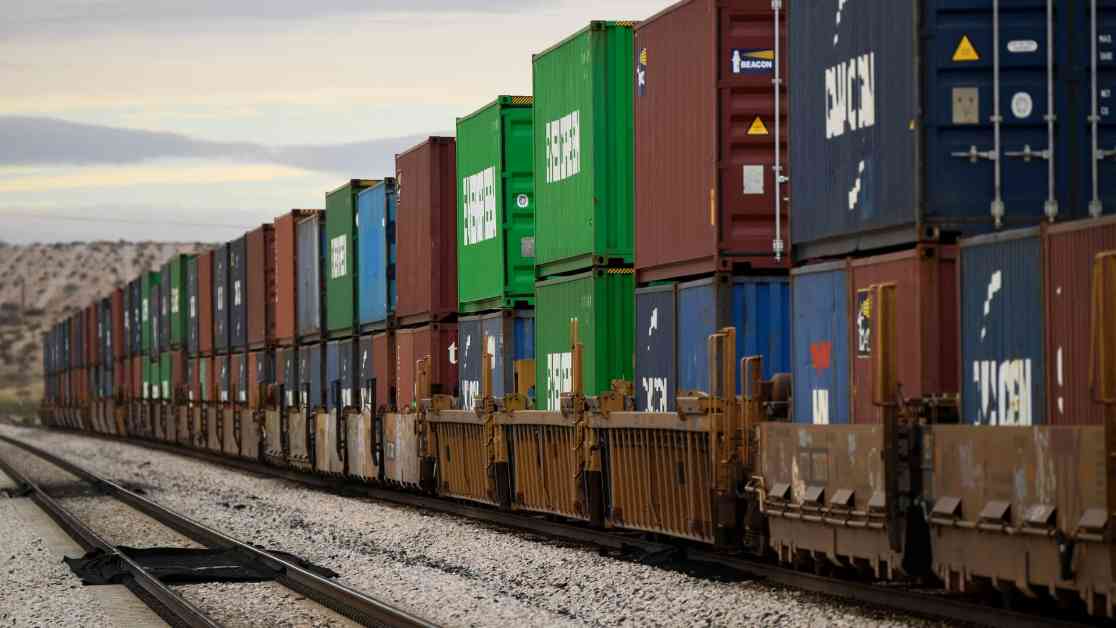China-Mexico Freight Traffic Surges Amid U.S. Trade War Tariffs
As tensions rise in the U.S.-China trade war, the freight traffic between China and Mexico has seen a significant surge. This increase in trade comes at a time when tough tariff talk is dominating the political landscape. New data reveals a notable uptick in the flow of raw materials and components from China into Mexico. These materials are then manufactured into fully assembled items, which are subsequently transported into the U.S. via rail or truck.
Nearshoring of manufacturing has become a popular strategy, with more Chinese companies relocating their production facilities from China to Mexico. Jordan Dethwart, president of Redwood Mexico, a cross-border logistics specialist, notes that these companies are taking advantage of Mexican manufacturing facilities and Chinese third-party logistics services. By importing components and raw materials from China and assembling products in Mexico, these companies are able to label their goods as “Made in Mexico,” benefiting from the favorable terms of the USMCA.
The move towards nearshoring allows companies to change the origin of goods, known as the “economic nationality” of a product. To qualify as a Mexican product, items must undergo a substantial transformation during the manufacturing process. Mary Lovely, from the Peterson Institute for International Economics, emphasizes that certain sectors, such as automobiles and textiles, play a crucial role in determining the origin of a product.
The trend of manufacturing shift is not limited to Chinese companies but also includes European-based companies that are now opting to manufacture their products in Mexico. Simon Cohen, CEO of Henco Logistics, highlights the strong demand for nearshoring, with items being produced in Mexico and shipped to the U.S. The “China Plus One” strategy, combined with the benefits of the USMCA, has fueled this shift in manufacturing operations.
Data from Xeneta shows a substantial increase in container trade between China and Mexico, with container traffic up by 26.2% in the first half of 2024. This growth in trade is further evidenced by increased volumes of Mexico exports to the U.S. recorded by VesselBot during the same period.
Mexico’s strategic trade agreements and economic alliances make it an attractive destination for setting up manufacturing operations. With 13 free trade agreements covering 50 countries, including the USMCA, Mexico offers a favorable environment for companies looking to expand their production capabilities.
The surge in trade between China and Mexico, despite ongoing political tensions and tariff threats, underscores the resilience and adaptability of global supply chains. The dynamics of international trade are constantly evolving, with companies seeking to optimize their operations and mitigate risks associated with tariffs and trade policies.
Subheadings:
China-Mexico Trade Dynamics
Impact of Nearshoring on Manufacturing
Role of USMCA in Shaping Trade Flows
The increase in trade between China and Mexico is not solely driven by tariff considerations but also by the strategic advantages offered by Mexico as a manufacturing hub. Companies are leveraging Mexico’s proximity to the U.S. market, as well as its trade agreements, to streamline their supply chains and enhance their competitiveness.
The recent escalation of tariffs and trade barriers by the Biden administration has further incentivized companies to explore alternative trade routes and manufacturing locations. The shift towards Mexico as a key node in North American supply chains is expected to continue, with the country playing a pivotal role in facilitating the flow of goods between China and the U.S.
The ongoing review of the USMCA, scheduled to begin in 2026, raises questions about the future of trade relations between the three countries. As geopolitical tensions persist and trade policies evolve, Mexico’s role in global trade dynamics is likely to expand, with implications for industries ranging from automotive to technology.
In conclusion, the surge in freight traffic between China and Mexico reflects the changing landscape of international trade. Companies are adapting to geopolitical uncertainties and tariff pressures by reconfiguring their supply chains and manufacturing operations. Mexico’s strategic position and trade agreements make it an attractive destination for companies looking to optimize their trade routes and production processes. As global trade continues to evolve, Mexico’s role as a key player in North American supply chains is set to grow, shaping the future of international trade relations.
















